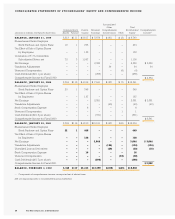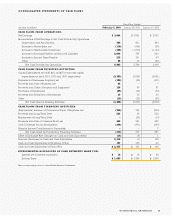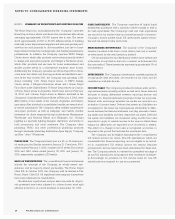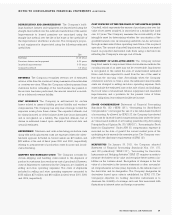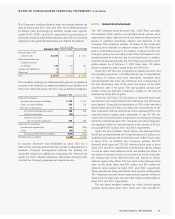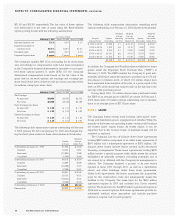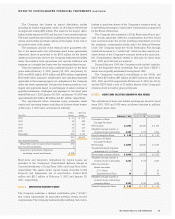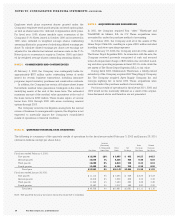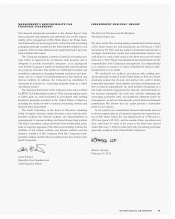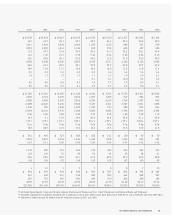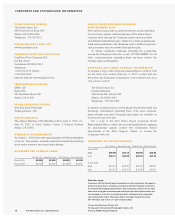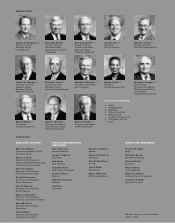Home Depot 2001 Annual Report Download - page 35
Download and view the complete annual report
Please find page 35 of the 2001 Home Depot annual report below. You can navigate through the pages in the report by either clicking on the pages listed below, or by using the keyword search tool below to find specific information within the annual report.
NOTES TO CONSOLIDATED FINANCIAL STATEMENTS (CONTINUED)
33The Home Depot, Inc. and Subsidiaries
The Company also leases an import distribution facility,
including its related equipment, under an off-balance sheet lease
arrangement totaling $85 million. The lease for the import distri-
bution facility expires in 2005 and has four 5-year renewal options.
The lease agreement provides for substantial residual value guar-
antees and includes purchase options at the higher of the cost or
fair market value of the assets.
The maximum amount of the residual value guarantees rela-
tive to the assets under the off-balance sheet lease agreements
described above is projected to be $799 million. As the leased
assets are placed into service, the Company estimates its liability
under the residual value guarantees and records additional rent
expense on a straight-line basis over the remaining lease terms.
Total rent expense, net of minor sublease income, for the fiscal
years ended February 3, 2002, January 28, 2001 and January 30,
2000, was $522 million, $479 million and $389 million, respectively.
Real estate taxes, insurance, maintenance and operating expenses
applicable to the leased property are obligations of the Company
under the lease agreements. Certain store leases provide for con-
tingent rent payments based on percentages of sales in excess of
specified minimums. Contingent rent expense for the fiscal years
ended February 3, 2002, January 28, 2001, and January 30, 2000 was
approximately $10 million, $9 million and $11 million, respectively.
The approximate future minimum lease payments under
capital and operating leases, including off-balance sheet leases,
at February 3, 2002 were as follows (in millions):
Capital Operating
Fiscal Year Leases Leases
2002 $ 41 $ 517
2003 42 495
2004 43 447
2005 44 415
2006 44 394
Thereafter 577 5,139
791 $7,407
Less imputed interest 559
Net present value of capital lease obligations 232
Less current installments 4
Long-term capital lease obligations,
excluding current installments $ 228
Short-term and long-term obligations for capital leases are
included in the Company’s Consolidated Balance Sheets in
Current Installments of Long-Term Debt and Long-Term Debt,
respectively. The assets under capital leases recorded in Net
Property and Equipment, net of amortization, totaled $199
million and $213 million at February 3, 2002 and January 28,
2001, respectively.
NOTE 6. EMPLOYEE BENEFIT PLANS
The Company maintains a defined contribution plan (“401(k)”)
that covers substantially all associates meeting certain service
requirements. The Company makes weekly matching cash contri-
butions to purchase shares of the Company’s common stock, up
to specified percentages of associates’contributions as approved
by the Board of Directors.
The Company also maintains a 401(k) Restoration Plan to pro-
vide certain associates deferred compensation that they would
have received under the 401(k) matching contribution if not for
the maximum compensation limits under the Internal Revenue
Code. The Company funds the 401(k) Restoration Plan through
contributions made to a “rabbi trust,”which are then used to pur-
chase shares of the Company’s common stock in the open mar-
ket. Compensation expense related to this plan for fiscal years
2001, 2000 and 1999 was not material.
During February 1999, the Company made its final contribu-
tion to the Employee Stock Ownership Plan and Trust (“ESOP”),
which was originally established during fiscal 1988.
The Company’s combined contributions to the 401(k) and
ESOP were $97 million, $84 million and $57 million for fiscal years
2001, 2000 and 1999, respectively. At February 3, 2002, the 401(k)
and the ESOP held a total of 33 million shares of the Company’s
common stock in trust for plan participants.
NOTE 7. BASIC AND DILUTED EARNINGS PER SHARE
The calculations of basic and diluted earnings per share for fiscal
years 2001, 2000 and 1999 were as follows (amounts in millions,
except per share data):
Fiscal Year Ended
February 3, 2002 January 28, 2001 January 30, 2000
Calculation of Basic
Earnings Per Share:
Net earnings $ 3,044 $ 2,581 $ 2,320
Weighted average number of
common shares outstanding 2,335 2,315 2,244
Basic Earnings Per Share $ 1.30 $ 1.11 $ 1.03
Calculation of Diluted
Earnings Per Share:
Net earnings $ 3,044 $ 2,581 $ 2,320
Tax-effected interest expense
attributable to 31/4% Notes ––17
Net earnings assuming dilution $ 3,044 $ 2,581 $ 2,337
Weighted average number of
common shares outstanding 2,335 2,315 2,244
Effect of potentially
dilutive securities:
31/4% Notes – – 51
Employee Stock Plans 18 37 47
Weighted average number of
common shares outstanding
assuming dilution 2,353 2,352 2,342
Diluted Earnings Per Share $ 1.29 $ 1.10 $ 1.00





